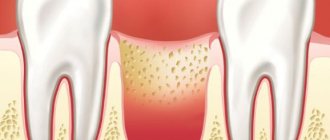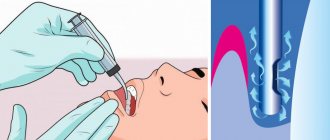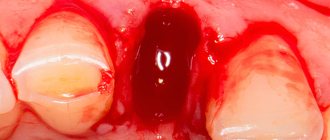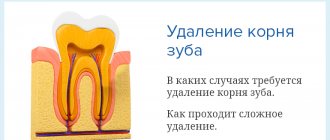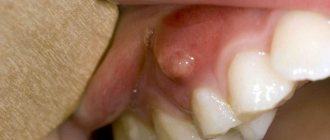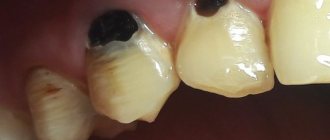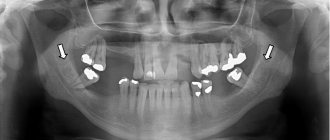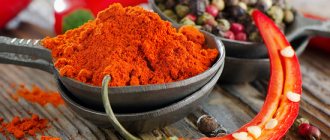Dental alveolitis is an inflammatory process that affects the jaw socket after tooth extraction. It becomes infected, which occurs when the integrity of the blood clot is damaged or absent. If the blood clot does not form after removal or moves, exposing the wound, bacteria will inevitably enter it and provoke an inflammatory process.
- When to use:
Inflammation of the socket after removal - Type of anesthesia:
Local - Procedure time:
Up to 1 hour - After the procedure:
Taking antibiotics (determined by the doctor) - Treatment period:
3-4 visits 2 weeks
Causes of the disease
The development of the disease can be caused by many reasons, from violation of the treatment regimen to serious pathologies. The most common factors:
- Excessively frequent mouth rinsing. Causes blood to be washed out of the socket, facilitating the penetration of bacteria there;
- The entry of food into the hole, which, if cleaned poorly, causes an inflammatory process;
- Low immunity, lack of vitamins, minerals and trace elements in the body;
- Complications after surgery;
- During the operation, oral hygiene was poor; dental plaque got there and was not removed.
Symptoms
The first and main sign of the disease is that the socket in place of the extracted tooth does not heal. If blood constantly oozes out at the removal site, then the formation of a protective blood clot is disrupted and the situation needs to be corrected. Remember, an open wound is not protected from bacteria, so unwanted inflammation can begin there at any moment. When this process occurs, purulent discharge and bad breath appear. It is important not to self-medicate, but to consult a doctor to adjust treatment.
Results and discussion
When analyzing patient complaints, the first place was occupied by the pain symptom. In all patients who took part in the study, pain of varying characteristics (sharp, twitching or aching) in the socket, which arose on the 2-3rd day after tooth extraction, was the main reason for visiting a dentist; the second place among the complaints was presence of bad breath. At the same time, the majority of patients did not note any disturbance in their general condition; in both groups, when measuring body temperature, it was within the subfebrile range, which indicated the absence of pronounced systemic changes requiring antibiotic therapy.
During control examinations of patients on the 3rd day: in group 1, the majority of patients (60%, n
=9) still noted the pain symptom as severe, the remaining participants (40% (
n
=6)) - as moderate. All patients of group 1 noted an unpleasant taste of iodine in the mouth and bad breath, which is directly related to the use of iodoform turunda. During examination, the turunda was in place in all cases; food contamination of its upper layer was noted. The edges of the wound in all cases were hyperemic and swollen. The replacement of the turunda was carried out according to the standard method, but no additional antiseptic treatment was performed.
In the 2nd group with the drug Cholisal, only 5 patients noted a pronounced pain reaction, 6 noted moderate pain, and the remaining 4 patients did not note any pain on the 3rd day from the start of using the drug. Complaints of an unpleasant taste in the mouth were noted by only 20% ( n
=3).
When examining the socket of the extracted tooth, 80% ( n
= 12) of patients were noted to be filled with gel without signs of foreign contamination. This fact can be explained by the mode of administration of the drug - 4 times a day, after preliminary rinsing with water if necessary, which makes it possible to eliminate possible food debris. When interviewing patients, no difficulties with self-administration of the drug were identified.
On the 5th day, patients of group 1 with iodoform turunda noted a pronounced pain reaction in 6 cases, moderate pain in 5 cases, and only 4 patients did not have pain complaints during the last day. Complaints about taste and odor from the mouth still persisted in all patients of group 1, which could be due to significant contamination of the upper layer of the turunda with food debris and plaque. During this visit, the turunda was also replaced with a new one without additional antiseptic treatment. During the dressing, the formation of epithelium on the inner side of the mucous socket, expressed to varying degrees, was noted in all patients.
In group 2, where Cholisal was used, the dynamics of subjective sensations were much more pronounced - only 5 patients noted slight discomfort in the area of the extracted tooth socket, and the remaining 10 did not note any pain or other sensations for at least the last 2 days. There were no complaints about organoleptic properties during this period. Upon examination, the sockets in all patients were filled with gel without foreign impurities; there was a pronounced convergence and epithelization of the edges of the wound, and a decrease in the mouth of the socket. The surrounding mucosa retained slight swelling and hyperemia only in 2 cases.
Due to the lack of objective tools for measuring pain symptoms, we focused on laboratory parameters to assess the effectiveness of treatment. However, complaints and results of clinical examination were recorded at each follow-up visit.
When analyzing biochemical parameters before treatment in patients diagnosed with alveolitis, the content of PI in the blood differed from the corresponding indicators in healthy individuals [5]. This, in turn, naturally led to a change in the concentration of AA, one of the main products of metabolism of P.I. Analysis of PGE2 content also revealed a significant increase in indicators compared to healthy individuals (Table 1).
Table 1. Biochemical parameters of inflammatory markers before treatment Note. 1 - see the list of references, paragraph 4. * - the differences in indicators in healthy individuals and patients diagnosed with “alveolitis” of the “dry socket” type are significant (p <0.05). Thus, the local inflammatory reaction in the mouth is reflected at the systemic level, which made it possible to use these parameters to objectify the assessment of the use of the drug Cholisal in the treatment of patients diagnosed with alveolitis.
Analysis of biochemical parameters in patients with alveolitis on the 5th day after the start of treatment showed that the content of PI, AA, and PGE2 in whole gingival blood significantly decreased compared to the initial level in both clinical groups (Table 2).
Table 2. Biochemical parameters of inflammatory markers on day 5 Note. 1 - see the list of references, paragraph 4. * - the differences in indicators in healthy individuals and patients of groups 1 and 2 are significant (p <0.05). However, a more pronounced, statistically significant decrease in indicators was observed in group 2, where patients were prescribed the drug Cholisal. During this period, satisfactory clinical regeneration of the tooth socket had not yet occurred, however, biochemical parameters had a pronounced positive trend. Probably, these data on the level of PI, AA, PGE2 in patients of group 2, in contrast to patients of group 1, are explained by the anti-inflammatory effect of the drug Cholisal. The obtained biochemical parameters fully correlated with the subjective data of the patients during control examinations.
During the control examination on the 10th day in the 1st group with iodoform turunda, when collecting complaints, only 4 patients noted slight discomfort in the area of the extracted tooth socket, and the remaining 11 did not note any pain during the last day. At this stage, the main complaint of patients was an unpleasant taste and odor from the mouth. Clinical examination revealed the absence of swelling and hyperemia of the mucous membrane near the hole in all patients, however, in all cases, contamination of the upper layer of the turunda was still noted.
In group 2 with Cholisal, by this time patients did not show any complaints. Upon examination, the edges of the socket were epithelialized in 100% ( n
=15) cases, in 80% (
n
=12) of patients the edges were brought as close as possible, but a gap was maintained for drug administration.
Analysis of biochemical parameters, carried out on the 10th day from the start of treatment, showed a correlation with clinical examination data and revealed the high effectiveness of local use of the drug Cholisal in the treatment of alveolitis. Thus, all the studied biochemical indicators in group 2 were at the level of normal values or had a slight difference, while in patients of group 1 the indicators still exceeded the normal level for all studied positions (Table 3).
Table 3. Biochemical parameters of inflammatory markers on the 10th day Note. 1 - see the list of references, paragraph 4. * - the differences in indicators in patients with alveolitis before and after treatment are significant (p <0.05).
Based on the data of clinical examinations and the subjective sensations of patients, the reduction or complete elimination of the pain symptom and inflammatory component occurred 2-2.5 times faster in the group of patients who used Cholisal, compared to the group of standard methods of alveolitis management. This also applies to indicators of biochemical processes - their dynamics in the group with Cholisal were better on all points and correlated with clinical data (Tables 4, 5,
Table 4. Dynamics of biochemical parameters on the 5th day from the start of treatment
Table 5. Dynamics of biochemical parameters on the 10th day from the start of treatment Fig. 2, 3).
Rice. 3. Dynamics of PGE2 indicators on the 5th and 10th days by group. Fig. 3. Dynamics of prostoglandin E2 indices on the 5th and 10th days by groups.
Rice. 2. Dynamics of FI indicators on the 5th and 10th days by group.
Summing up the results of the study, it should be noted that the dynamics of subjective sensations towards improvement in patients of group 2 compared with those in group 1 already on the 3rd day from the start of treatment and further throughout the entire period, in our opinion, is associated with a pronounced analgesic and antiseptic effect of the drug Cholisal. Local administration of the gel promotes a direct effect on the site of inflammation by suppressing the synthesis of cyclooxygenase and prostaglandins responsible for the reaction cascade. When surveyed, the biggest advantages were cited by study participants as the rapid onset of an analgesic effect and the ability to use Cholisal at home, which makes the procedure more convenient, although it requires prior training. However, none of the patients experienced any difficulties with self-administration of the drug.
The gel form promotes long-term stay in the injection zone, which was noted by patients. From the point of view of clinicians, this effect helps to prolong the drug effect on the socket, which is undoubtedly a big plus.
Thus, based on an analysis of the clinical course, subjective indicators (patient complaints, ease of self-administration) and biochemical research data when using the drug Cholisal for the treatment of alveolitis, which occurs as a “dry socket”, its effectiveness has been established, which is not inferior and even has advantages in comparison with the classical method of managing patients in the treatment of this nosology.
Types of alveolitis:
- Serous;
- Purulent;
- Purulent chronic type.
With the serous version, the patient suffers from aching pain, which noticeably intensifies during meals. Body temperature does not increase, and general health is within normal limits. There is no blood clot in the hole where the tooth was removed. Leftover food accumulates there. This form of the disease develops within 3 days after surgery. If treatment is not started immediately, complications will arise.
Purulent alveolitis after tooth extraction is characterized by severe pain. An unpleasant odor appears from the oral cavity. Body temperature rises to 38 degrees. A person feels depressed, tired, lethargic. The skin becomes pale. The pain intensifies while eating food. Possible swelling of the facial muscles and enlarged lymph nodes. Palpation causes pain.
The chronic form of the disease implies periodic stabilization of the condition. Overgrowth of soft tissue occurs. Pus forms in the hole after surgery. A bluish tint may be observed.
How to treat alveolitis after tooth extraction
It happens that the empty socket becomes inflamed after tooth extraction , the temperature rises, and an unpleasant odor is heard from the mouth. And all this “happiness” lasts up to two weeks. If these symptoms are familiar, then most likely you are dealing with alveolitis.
Alveolitis is inflamed socket walls with reduced protective properties, which can occur as a result of alcohol intake, or a traumatic tooth extraction operation, or improper oral care, or if the integrity of a blood clot is violated by the patient. Also, one of the reasons may be an inflammatory process as a result of the development of an infection that is located in the socket of a diseased tooth, especially if it is removed due to exacerbation of periodontitis, or complications of periodontitis. Against this background, a general decline in immunity, characterized by the patient’s age, and previous illnesses can play a negative role.
Sometimes alveolitis after tooth extraction can lead to suppuration of the affected area, and at the same time to necrosis of the affected tissues of the oral cavity. Signs of alveolitis after tooth extraction, in the opinion of the vast majority, are very harmless. Something like “it hurts and it goes away.” This is not true, in its neglected form, this disease can deprive teeth in the literal sense of the word.
Alveolitis after tooth extraction symptoms
The disease is characterized by the presence of pain in the socket of the extracted tooth, which only increases during meals, but never disappears. The rest of his health, including body temperature, is completely normal. The hole itself may be filled with a blood clot, there may also be food particles and saliva secretions there. The mucous membrane of the gum itself becomes inflamed red, and touching it causes discomfort.
If at this stage of development you do not seek help from a specialist, then in the future, the pain will move to the ear, temple, and to the part of the head where the affected area is located. At the same time, the state of health will no longer be characterized as normal, the body temperature rises, eating due to pain becomes more difficult from time to time, and the hole itself will be covered with a gray coating with a pronounced unpleasant odor. The lymph nodes under the jaw swell, and also cause pain when moving the jaw, and swelling forms on the face. Also, alveolitis itself can cause a number of other, no less unpleasant diseases.
Treatment of alveolitis after tooth extraction
To cure this disease, you should remember one important rule - no amateur activities. Only a doctor can provide truly effective assistance, and no one else. Folk remedies will remove the symptoms, but will not make the disease go away.
The doctor himself will begin the treatment directly - under local anesthesia, the treatment of the hole will begin. With the help of a syringe and an antiseptic, everything unnecessary is washed out of it - saliva, food, clots, pus. Next, with a surgical spoon they remove everything that could not be removed. After this, the hole is again treated with an antiseptic, dried, and closed with a gauze strip soaked in an antiseptic and anesthetic. If alveolitis is in the initial stage, then after treatment the pain does not return, and the inflammatory areas resolve within a couple of days. The main thing is not to let pus appear in the hole; in this case, even with active treatment, the pain will not go away.
Therapeutic treatment
Treatment is carried out according to a standard scheme and it is important to start it in a timely manner:
- Cleaning the hole from food debris, plaque, and dead tissue;
- A thorough inspection of the hole, checking for the absence of roots and foreign elements;
- Washing the wound with hydrogen peroxide;
- Drying the wound;
- Putting anti-inflammatory drugs into the hole.
After treatment, the doctor gives recommendations to the patient on oral care. A few days later, the patient comes back for an examination to make sure that the treatment has given positive results and the wound is healing. It is important to rinse your mouth with herbal decoctions at home. Do not eat hard foods. For pain relief, you can use Nimesil or Ketanov.
Why does alveolitis begin?
A slight inflammation in the socket is an inevitable process, since during tooth extraction tissue is injured and an open wound appears, and the environment in the mouth is unsterile. But alveolitis does not occur in everyone. So why does an infection get into the hole that the human body cannot cope with on its own?
Causes of infectious inflammation in the socket
The natural protective barrier is destroyed
A blood clot forms at the site of the extracted tooth; it closes the wound and protects it from infection. If this natural barrier is destroyed, for example by rinsing the mouth after tooth extraction, then the infection can penetrate into the tissue of the hole and provoke inflammation.
Poor oral hygiene
Bacteria live in the oral cavity. During the doctor’s manipulations, as well as after them, particles of tartar or soft plaque can get into the wound. This is a very good environment for bacteria, so they multiply quickly. Severe inflammation begins.
Poor sterilization of surgical instruments
Paradoxically, an infection in the socket can also be caused by a dental surgeon who uses poorly sterilized instruments.
Violation of the rules for processing the tooth socket
After surgery, especially if the extracted tooth had a granuloma, the doctor must carefully treat the wound so that it fills with blood to form a clot, and apply sterile cotton wool. Neglecting these rules can provoke alveolitis.
Violation of doctor's recommendations after removal
Even if you did not make a mistake in choosing a dental surgeon and the removal went well, an infection can get into the wound. This happens if you violated the doctor’s recommendations for caring for the hole. For example, they disturbed the wound with a tongue or some object and introduced an infection into it.
Decreased immunity
The cause of alveolitis may be decreased immunity or exhaustion of the body. This happens after a serious illness.
Caries
If there are teeth in the oral cavity affected by caries, then there is always a possibility that after removal you will encounter alveolitis.
To avoid the occurrence of alveolitis after tooth extraction, choose a dental surgeon responsibly and follow all his recommendations. A good doctor will definitely advise you to undergo professional oral hygiene before removal. This will reduce the risk of infection getting into the socket.
Prevention measures
Naturally, it is necessary to consult a doctor in a timely manner and begin treatment, since the inflammatory process can lead to serious consequences. For preventive purposes, you must remember the following:
- Tooth extraction operations should only be performed by a trusted, experienced specialist who works specifically in the field of surgery;
- Follow all doctor’s recommendations for treatment and recovery exactly to avoid negative consequences;
- Undergo complex treatment without completing it in advance because you feel well. Interruption of therapy until complete recovery can cause an aggravation of health, lead to the formation of bacteria and a new inflammatory process.
With proper treatment and no complications, the problem is cured within a few days.
The patient must remain in bed for several days to fully recover. Minor pain in the area of the extracted tooth may periodically bother you for 3 weeks, but it will be less intense and will gradually go away. Remember, it is important to consult a doctor in a timely manner and undergo comprehensive treatment so as not to bring your health to a critical point. This article is for informational purposes only, please consult your doctor for details! Ask your doctor about contraindications and side effects.
Methods for diagnosing alveolitis
How long the alveolitis will take to heal depends on timely diagnosis and treatment. Therefore, at the first signs of illness, you should consult a dentist. Identification of pathology occurs after listening to complaints, collecting anamnesis (where there is recent tooth extraction) and examining the socket cavity.
Sometimes the doctor prescribes an x-ray examination, which helps to detect tooth fragments and other foreign fragments in the alveolus. In rare cases, when alveolitis of the tooth socket , computed tomography is prescribed for the purpose of differential diagnosis of other diseases (trauma, tumor, etc.).
Treatment of alveolitis
The goal of therapy is to eliminate the infection, prevent complications and maintain healthy teeth. The main method of treatment is curettage (scraping) of the tooth socket. The hole is cleaned of foci of infection, necrotic tissue, and tooth fragments. Afterwards they are washed with an antibiotic solution. In case of severe pain, the procedure is performed under local anesthesia.
To speed up wound healing, anti-inflammatory gels, rosehip and sea buckthorn oil, Kalanchoe and propolis juice, and vitamin A are used topically. To reduce the intensity of pain, local analgesic applications are prescribed.
Reference! It is advisable to take systemic antibiotics only if there is an infection. Otherwise, the risk of complications from the digestive system increases.
Treatment of alveolitis is aggravated by immunodeficiency states, therefore, to achieve the desired result, vitamin complexes and immunostimulating drugs are prescribed in parallel.
Physiotherapeutic procedures provide a good anti-inflammatory, wound healing and analgesic effect:
- laser therapy,
- electrophoresis (administration of a drug through the mucous membrane using an electric current),
- ultraphonophoresis (via ultrasound).
If all recommendations are followed and treatment is started in a timely manner, it is possible to achieve complete recovery, stable and long-term remission. In general, the prognosis of alveolitis is favorable; it depends on the state of the immune system, the presence of concomitant diseases, as well as timely seeking medical help and adequate therapy.
Symptoms
After tooth extraction, intense pain normally persists throughout the day. As healing progresses, the severity of pain decreases and completely disappears within 1–3 days. With alveolitis, on days 3–5, severe throbbing pain is felt at the site of the extracted tooth. As the infectious-inflammatory process progresses, the pain intensifies and spreads to the affected half of the face.
When examining the oral cavity, hyperemic (reddened) swollen gums are discovered. The blood clot in the socket is absent or partially preserved, covered with a gray coating. On palpation, the submandibular lymph nodes are enlarged.
The general condition is aggravated by the toxic-infectious syndrome:
- weakness,
- increased fatigue,
- low-grade fever.
Patients complain of an unpleasant taste in the mouth, bad breath, and increased salivation. Due to constant pain, appetite decreases and night sleep is disturbed. Teeth hypersensitive to cold and hot food.
Complications of alveolitis
Inflammation of the tooth socket has two possible outcomes: complete recovery or transition to osteomyelitis, odontogenic sinusitis, gumboil.
The most severe complication is osteomyelitis. This is a purulent, infectious-inflammatory process in the jaw bone, which leads to necrosis of bone tissue. If the course of osteomyelitis is unfavorable, the spread of infection can lead to meningitis (inflammation of the membranes of the spinal cord and brain), brain abscess (formation of a purulent cavity in the skull), sepsis (blood poisoning), which can cause death.
